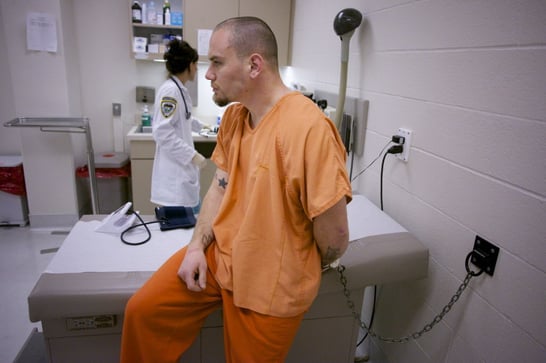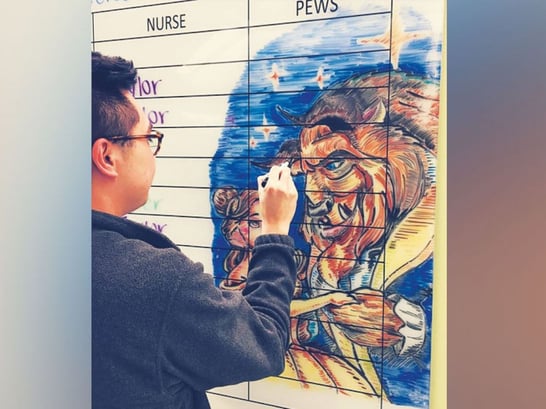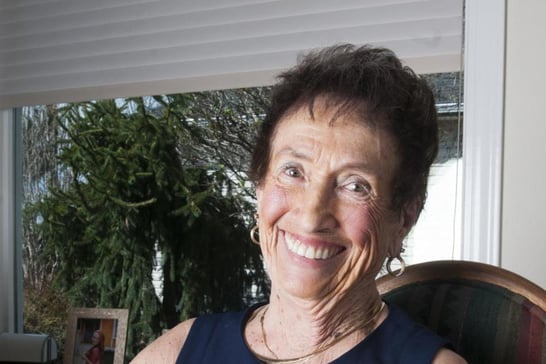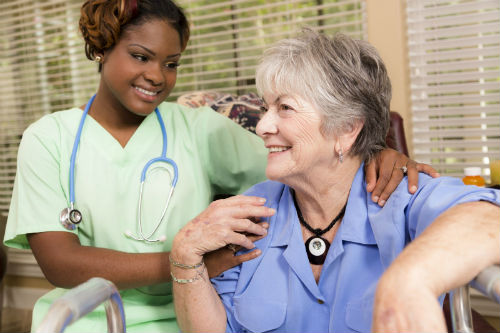 Have you ever considered your profession in a prison? Have you wondered what it’s like to be a Nurse in a prison? Perhaps you didn’t realize that prisons employ Nurses. It’s a necessity for the prisoners as they are patients with medical conditions that have been neglected for years.
Have you ever considered your profession in a prison? Have you wondered what it’s like to be a Nurse in a prison? Perhaps you didn’t realize that prisons employ Nurses. It’s a necessity for the prisoners as they are patients with medical conditions that have been neglected for years.What To Know Before You Become A Correctional Nurse
Posted by Pat Magrath
Tue, Apr 25, 2017 @ 11:28 AM
 Have you ever considered your profession in a prison? Have you wondered what it’s like to be a Nurse in a prison? Perhaps you didn’t realize that prisons employ Nurses. It’s a necessity for the prisoners as they are patients with medical conditions that have been neglected for years.
Have you ever considered your profession in a prison? Have you wondered what it’s like to be a Nurse in a prison? Perhaps you didn’t realize that prisons employ Nurses. It’s a necessity for the prisoners as they are patients with medical conditions that have been neglected for years.Topics: prison nursing, correctional nursing, corrections nurse
Hospital Impact: Nurse Leadership's Role In Reducing Burnout
Posted by Erica Bettencourt
Thu, Apr 20, 2017 @ 02:52 PM
 In order to provide top quality care to their patients, Nurses must be focused and alert. Burnout in Nurses is worrisome because common side effects are forgetfulness, impaired concentration, anxiety, and depression. As a Nurse leader you want to make sure patient's lives are in good hands and the Nurses are well.
In order to provide top quality care to their patients, Nurses must be focused and alert. Burnout in Nurses is worrisome because common side effects are forgetfulness, impaired concentration, anxiety, and depression. As a Nurse leader you want to make sure patient's lives are in good hands and the Nurses are well. The problem of nursing burnout has been in a state of evolution for years. For many of these years, the 12-hour shift was the primary focus. However, 12-hour shifts provide nurses time away from the bedside necessary for rest, family time and self-care, allowing for a rested and refreshed start to new shifts.
Several stressors lead to high levels of pressure and nurse burnout. These include:
- High patient acuity (years ago, these patients would have been in the ICU)
- High nurse-to-patient ratios (not acuity-based)
- Multiple discharges and admissions (many nurses will discharge and admit an entire team of patients during their shift)
- Lack of ancillary support and resources
- Leaders who assume that nurses “can take one more patient”
- Physicians who expect nurses to drop everything and attend to their needs
- Interruptions while on their break
- The expectation that nurses are all-giving.
However, the most important stressor includes an old mindset held by organizational and nursing leadership: Nurses who voice concerns related to patient safety and workload are viewed as complainers. As nursing leaders, we must recognize the demands placed on our nurses, validate their concerns, and through best practices and common sense, use our leadership to provide support.
The most important skill of a nursing leader is the ability to listen to nurses. The nursing leader must be engaged in the discussions and have a physical presence in the department. Engaging with nurses allows for an open dialogue and a discussion of ideas, and provides validation.
Validation, in turn, lowers nurses’ stress levels because they know they are being heard. Open dialogue provides the nursing leader a forum to foster best practices, find workable solutions for departmental issues, and teach leadership skills through mentoring sessions.
Nursing leaders must hold nurses accountable who are not carrying their load. Modifications in behavior by the nurse will indicate action and support from the nursing leader. In addition, nursing leaders must know, understand and demonstrate a deep caring for their nurses. This is why having a presence on the unit is so important. Actions always speak louder than words, and we must model healthy, professional and supportive behaviors for our nurses.
Staff meetings can be of great benefit and should include discussions regarding new organizational policies, processes and outcomes from higher leadership meetings. One way to engage nursing input in staff meetings is to post an agenda and ask for additional items the nurses would like to discuss or present. Allowing nurses to create ideas, and to volunteer according to their interests and passions, fosters a sense of belonging that is necessary for engagement.
Imagine nurses researching best practices regarding care of a complex patient diagnosis new to your unit. The nurses present their research and provide the education to the nursing staff. Recognition encourages more nurses to contribute to improving the unit.
As nursing leaders, we must teach and empower our nurses to lead. Self-care has become a buzzword in nursing. Nurses are expected to care for themselves, but are sabotaged by the stress and the demands of the patient care environment. However, nursing leaders must provide supportive environments that foster self-care. For example, a competent team can handle discharge and admissions paperwork and patient education, allowing nurses to attend to their patient loads.
Finally, and most importantly, nurses need to be told that it is OK to take care of their own needs during their work shift. They need to feel confident that the nurses who are covering their team are knowledgeable and competent.
Self-care is included in many of the BSN and master’s-level nursing programs. Nursing programs are teaching leadership skills focusing on professional communication and how to achieve self-care in the work environment. Using best practice and leadership practices learned in nursing programs, nurses should present new ideas and evidence-based models to their nursing leadership.
By communicating in a professional fashion with the leadership, nurses will feel empowered and validated by having a voice. This new refreshing outlook is a far cry from the old, when nurses were expected to give up their chairs for physicians.
Topics: nurse leadership, Nurse burnout
 As a website dedicated to Nurses to help keep you aware of employment and educational opportunities as well as provide information and a sense of community, we share this article with you about bullying in the Nursing profession. It’s sad to know this goes on in a professional work environment and can put a patient’s health and recovery at risk.
As a website dedicated to Nurses to help keep you aware of employment and educational opportunities as well as provide information and a sense of community, we share this article with you about bullying in the Nursing profession. It’s sad to know this goes on in a professional work environment and can put a patient’s health and recovery at risk.The nursing profession has consistently ranked No. 1 in Gallup's annual poll of Honesty and Ethical Standards in Professions for the past 15 years — which makes the rampant bullying and hazing that persists among nurses that much more surprising.
Judith Meissner, RN, MSN coined the phrase "nurses eat their young" in a 1986 article to describe the hostility young nurses face at the hands of their more experienced coworkers. In a follow-up article published 13 years later, Ms. Meissner said "students, new graduates and even experienced 'new hires'" still suffered intense bullying.
According to a 2017 blog post by Pittsburgh-based Select International Healthcare, roughly 85 percent of nurses have been abused by a fellow nurse and approximately one in three nurses have considered quitting the profession due to bullying.
Topics: bullying, Workplace Bullying, Nurse bullying
We Need To Do Something More Radical Than Awareness Month For Autism
Posted by Pat Magrath
Mon, Apr 17, 2017 @ 11:06 AM
 April is National Autism Awareness Month. The Autism Society states “National Autism Awareness Month represents an excellent opportunity to promote autism awareness, autism acceptance and to draw attention to the tens of thousands facing an autism diagnosis each year.”
April is National Autism Awareness Month. The Autism Society states “National Autism Awareness Month represents an excellent opportunity to promote autism awareness, autism acceptance and to draw attention to the tens of thousands facing an autism diagnosis each year.”
This article written by a mother of an 8-year old autistic boy moved me very much. While she welcomes and appreciates the efforts of making people aware of autism, she’s hoping people will be more open and tolerant to the behavior of autistic people. She gives a very clear view of what her day-to-day life is like and offers suggestions on how people can help when they witness a struggling parent. We’ve all seen toddlers throw a temper tantrum, but what do you do when you see an older child have one?
The author suggests we practice “radical hospitality”. Read on to discover what this concept is. Please let us know if this article educated and inspired you.
“Do you want to make a donation?”
“Excuse me?” I look up from my wallet, making sure that my son is still next to me. He is, but he seems agitated. We need to go.
The teenage cashier at the sporting goods store repeats the lines of his script: “April is Autism Awareness Month. Would you like to make a donation to Autism Speaks?”
“No . . . just the shinguards please. I’m in a hurry.”
I doubt the young man at the register realizes I’m in a hurry because I’m here with my severely autistic son, Finn, the tall 8-year-old who in the brief time we’ve been here ran full speed in the aisles, buried his face in the racks of workout gear, then tried to knock the soccer balls out of their bins. I think about saying something to the cashier, like “No donation — Sorry! Please just let me get my autistic son out of here before he tears apart your store!” I’m sure that would boost his awareness. But it would be rude, and beside the point.
Autism Awareness Month, now in its 13th year, does raise awareness, or at least boosts Web searches on autism. But awareness is different than recognition. Awareness doesn’t increase the number of places where parents like me can take our behaviorally challenged children, for example. My son can’t sit still in a movie theater for the length of a movie. He gets overstimulated in children’s museums. In most restaurants, his yelps and difficulty staying seated draw sharp looks. People want to eat in peace. I get that, but I don’t want to be a prisoner in my home either. And I can only spend so much time at the laundromat, where Finn can generally bang on the machines and push around the ancient carts without disturbing anyone.
Generations ago, you rarely saw people with severe developmental disabilities in public spaces. A child like Finn would likely have been separated from our family not long after birth and placed in a state-run institution, like the Walter E. Fernald Developmental Center, called the Massachusetts School for Idiotic and Feeble-Minded Children when it opened in the mid-1800s. I’m glad that didn’t happen, and not just because publicly run schools like the Fernald were closed after years of scandal and sometimes outright abuse. Having Finn in our lives has given us so many inexpressibly tender moments. When a dog passes us at Fresh Pond, and Finn presses his body into mine for comfort, or when he absently threads his fingers through mine as we walk down the street — I feel a surge of affection. “How much do I love you?” I ask. He lifts his hands in the air (at 8, he’s still nonverbal). “SO much!” I say. Sometimes, Finn is right there with me.
But then he isn’t. I still find it hard to read his moods and follow his lead, even when doing something as basic as running an errand. Awareness of autism doesn’t ease this challenge; I’m hyperaware, and yet still don’t know how to manage his tantrums. Our society has difficulty accommodating severely disabled children like mine, no longer toddlers, yet unable to feed or dress themselves, or even use the toilet. There are some private residential facilities, but they cost more than $200,000 a year. Even highly functional kids with autism don’t easily fit into society.
There are things people can do to make daily life better for children across the autism spectrum. If you see a mom struggling to contain an agitated child in the middle of a street or store, instead of staring mutely or averting your eyes, ask her, “Are you OK? Can I help?” Or even, “I think you’re doing a great job.” (I can no longer hide that my son behaves strangely for a boy his age. To be fully seen and still accepted is the greatest favor I’ve received from strangers.)
Or consider practicing radical hospitality. What’s radical hospitality? If your child has a classmate on the high-functioning end of the spectrum, invite that classmate to your child’s next birthday party. If you have friends or relatives with children on the spectrum, ask them how they’re doing, and then really listen to their response. Drop off a bottle of wine on their back porch if you know they’ve had a particularly rough week. Give to an organization that provides service dogs for autistic children, or volunteer as an autism buddy. If you run a store that’s big enough, create a space for a ball pit where autistic kids can play. You can, of course, wear a puzzle-shaped pin to show support, but that by itself is just paying lip service to the concept of “autism awareness.” Let’s all take the radical step of moving from awareness to actually helping families who are living with autism every day.
Topics: autism, autism awareness month, autistic
Nurse Brings Smiles To Patients With His Dry-Erase Artwork
Posted by Pat Magrath
Thu, Apr 13, 2017 @ 11:53 AM
 For any of you who work with sick children, you know how emotionally and physically draining it is for your patients and their families. And… for you too. Anything that can bring comfort and a smile to everyone involved is more than welcome.
For any of you who work with sick children, you know how emotionally and physically draining it is for your patients and their families. And… for you too. Anything that can bring comfort and a smile to everyone involved is more than welcome.This nurse’s drawings are bringing cheer to his young patients at Cook Children’s Medical Center in Fort Worth, Texas.
Edgar Palomo, 27, makes dry-erase artwork on the hematology/oncology floor to lighten the mood for the kids.
“I've always wanted to help people, which led me to nursing,” Palomo, who has been working at Cook Children’s for four years, wrote to ABC News. “I never wanted to pursue anything in art, so doing the drawings helps me to combine the two together in a positive and therapeutic manner.”
He said he’s been doing the drawings for the unit and patients for three years.
“As word of mouth goes around, it's gotten more frequent,” he explained of his elaborate creations. “I take requests from patients, families and staff. It can be a popular movie at the time or it might be something related to a holiday.”




Each drawing takes a few hours to complete, although Palomo said, “My job comes first.”
“I can usually only work on the drawings a little bit at a time when I have some free time,” he said. “And there is not always downtime. Therefore, a drawing can take one to two weeks, depending on how busy the unit is.”
Palomo is happy that his attempt to bring some cheerful color to the floor “can have such a positive impact on the kids.”
“Anything to bring a smile is worth doing,” he said.
Topics: nurse art, hospital art
 Smiling is contagious and really the only thing Nurses are okay spreading around. Being happier during your shift usually results in it going by a little faster. I wanted to know how Nurses made their shifts a little more enjoyable. I did some research and here’s what I discovered.
Smiling is contagious and really the only thing Nurses are okay spreading around. Being happier during your shift usually results in it going by a little faster. I wanted to know how Nurses made their shifts a little more enjoyable. I did some research and here’s what I discovered.
Besides the small birthday get togethers in the break room, there are other easy things you can try that can really boost morale.
Free Food
"If it's free, it's for me" my father-in-law always says. I agree, and what makes everyone happy? Free food. How do you get free food at work? One word… potluck. Each person brings in a food dish.
When people bring in their old family recipes or their favorite comfort food, you'll end up with a bunch of dishes from different cultures that you've never tried before. Trying new things can be fun!
You Win Some and You Lose Some
Some hospitals have sign up sheets for sports. Teams could play every sport from volleyball to basketball. We know playing sports inside a hospital is frowned upon. Even though the games are played outside of work, you can always talk some FRIENDLY team rivalry trash talk leading up to the big day. Some other game ideas that aren’t physical are card games and bingo.
Play Dress Up
Working holidays gives Nurses a reason to dress up, and if appropriate, act a little goofy around their patients. Nurses have dressed up in everything from elves to clowns. There is a hospital that celebrates “Tutu Tuesdays” where everyone wears a tutu over their scrubs.
Guess Who
Guessing games can be very interesting and an easy way to have a little fun. You can bring in pictures from when you were a kid, hang them on the cork board, and guess who's who. Another idea is bringing in pictures of your pets and guess who’s the owner. There is a lab department who hangs employee’s pet pictures in their blood bank area where other departments can see them. They create categories people can vote on. One category was, “Most likely to star in a Steven King movie”.
Be Thankful
I know when I'm thankful for things, it makes me feel good inside. Hospitals are putting up thank you boards or boards of recognition. One place has cardboard hands that you write on and pin to the board if you want to pat someone on the back for something good or helpful they did. It boosts people's morale and spirits. It also shows they’re all one big team and are there to help each other out.
Nursing is not all fun and games. There are those hard shifts, the sad moments, and trying times. Try to stay positive and lean on each other to get through those times. Cherish the good times and celebrations!
Topics: fun at work, boost morale, Fun Nurses
 Jokester, Trini Moad Snow, was a Nurse for over 40 years. She's now retired at age 91 but, talks about her happy days at work and the path to her passion. Moad Snow recalls picking vegetables after high school so she could save up enough money for Nurse training and that one time when she cut off an executive's tie! If you're interested in more of Trini's stories continue reading below.
Jokester, Trini Moad Snow, was a Nurse for over 40 years. She's now retired at age 91 but, talks about her happy days at work and the path to her passion. Moad Snow recalls picking vegetables after high school so she could save up enough money for Nurse training and that one time when she cut off an executive's tie! If you're interested in more of Trini's stories continue reading below.
When Trini Moad Snow retired, she decided to play a prank.
It was at a luncheon put on in 1992 by the staff of Mercy Medical Center, now Saint Alphonsus Medical Center in Nampa. Moad Snow, standing next to a hospital executive, pulled a pair of scissors out of her pocket and cut off the tie around his neck.
"I said, 'I never did like your ties,' and I cut it off!'" Moad Snow said, laughing.
"He said, 'You cut off my tie,'" she continued. "I said, 'I know, I don't like your ties.' I thought he was going to faint."
The people watching roared with laughter. Then, Moad Snow pulled out a box containing a nice, new tie and presented it to the executive, who gave her a hug.
"I get a card from him, every once in awhile," she said.
At 91, Moad Snow lives a laid-back life of retirement in Caldwell. She recalls tales from her nursing days that are usually tinged with humor and make her and her audience laugh. Moad Snow has the direct, matter-of-fact attitude you expect from a nurse, and her passion for her more-than-40-year-career is evident.
"I never did go to work unhappy," Moad Snow said. "I loved my work."
Moad Snow holds the distinction of having helped set up the first intensive care unit in Nampa at the Old Mercy Hospital, at a time when intensive care looked different from it looks like today. She saw the evolution of the nursing field from medical advancements to the style of uniforms.
Back in 1946, nurse training school cost Moad Snow a mere $75, a fact she likes to point out incredulously.
In today's dollars $75 is about $995, but that is still cheaper than a nursing student would pay for a semester's tuition at the College of Western Idaho, let alone three years of schooling.
To earn the money to train to be a nurse, Moad Snow, along with her friend Mickey Maybon, picked vegetables in the fields after graduating from Marsing High School. She swears she can still feel the cold lettuce in her hands as she packaged it for shipping.
When they finally earned enough money, they went into training at the old Sisters of Mercy hospital in Nampa.
Nursing was not at the top of Moad Snow's list of careers. She went to nursing school because Maybon convinced her to go. When she was almost finished with training, she had an interview set up in Seattle for an airline stewardess job. But a nun at the hospital turned her plans around.
"She said, 'Trini, you gotta give us a year. You owe us that,'" Moad Snow recalled.
She ended up working in the office of Dr. Warren B. Ross for the next eight years, then went to work at Old Mercy Hospital, an institution where she spent the rest of her career.
Moad Snow was a head nurse in the mid-1960s when she was walking down the hallway with two doctors who asked her if she likes to travel. They told her the hospital was setting up a new kind of unit that was becoming common all over the country, and she could go to New York to learn all about it.
"It wasn't really new; we took care of very ill patients out on the floor," Moad Snow explained. "But what was beginning to happen was they were beginning to group these patients into one area, and they called them 'intensive care units.'"
The new type of care would require nurses to have special training in things like the monitoring of patients' heart rhythms.
Moad Snow was told when she came back to Nampa that Old Mercy's intensive care unit would be fully set up and ready to go; all she would need to do was train the nurses. It didn't quite turn out that way.
"I came back, and I'll never forget ... I went home and cried that day," Moad Snow said.
One of the nuns at the hospital took her downstairs and showed her where she would set up the intensive care unit. She had two small rooms, and to wheel a patient out to the elevator to the surgical department she had to physically move her nurse's station desk.
Thankfully, that set-up was not permanent. Three months later, in September 1968, the Mercy Medical Center opened.
Although Saint Alphonsus is preparing to replace that facility this summer when it opens a new medical center nearby, the hospital was modern for its time, Moad Snow said, especially the ICU.
When the ICU was still in its early years, Moad Snow traveled to Russia to observe intensive medical care. She noticed they had a different policy than she was used to: Family members were allowed to stay nearby with the patient, as opposed to being kept at a distance. It broke all the rules Moad Snow learned, but it made such a difference in the patients' treatment and recovery.
When she got back to Idaho, Moad Snow tore up her rule book and let families visit patients in the ICU.
"It just made everything so much better," she added.
Moad Snow's career saw the application of new medical procedures.
She remembers the first time she watched a pacemaker get inserted. She thought the patient was going to die.
"And then when we got it connected and we saw that blip, and the patient's heart beating on the regular — it's pretty thrilling," Moad Snow said. "And I just couldn't get over how we could do things like that."
With all the changes, what hasn't changed about quality nursing is caring for patients, Moad Snow said.
Topics: ICU nurse, retired nurse
 Two men discuss their career paths in a female dominated work environment, Nursing. Brian Medley and Zain Rehman talk Nursing shortages, specialty options, salary, and more. Read below to find out more about the interview.
Two men discuss their career paths in a female dominated work environment, Nursing. Brian Medley and Zain Rehman talk Nursing shortages, specialty options, salary, and more. Read below to find out more about the interview.
Brian Medley, a nurse at Lurie Children's Hospital, and Zain Rehman, a nurse at Advocate Christ Medical Center Intensive Care Unit, talked about their career path.
Nursing has historically been a female-dominated field, but men are increasingly pursuing the career. The percentage of men in nursing is still small, only about 9 percent to 10 percent.
A nursing career holds many advantages for men, such as highly diverse patient care environments, career stability, and a competitive salary.
Resurrection University will host a "Thinking Out Loud" speaker series for men, by men.
"Men in Nursing" is a free event that brings together a panel of male nursing professionals to talk about what it's like to be a nurse in today's healthcare environment
EVENT DETAILS
WHEN: 10 a.m. to 2 p.m. Saturday
WHERE: Resurrection University, 1431 N. Claremont, Chicago
For more information, visit: www.resu.edu/meninnursing
IT'S A GOOD TIME TO BE A NURSE
Nurses are in high demand because of a current nursing shortage. Statistics from the World Health Organization show that the total number of nurses actively working in the U.S. health care field has decreased dramatically since 2000, therefore causing the demand for nurses to increase. Another reason for the shortage is that our country's aging population is generating a growing demand for services such as end-of-life and long-term care. The shortage of nurses crosses all specialties including faculty for nursing education program. That means graduating students can enter a job marketplace that is stacked in their favor. The job opportunities for nurses are expected to grow by 16 percent by 2025.
MANY TYPES OF NURSING SPECIALTY OPTIONS
The nursing field offers many different patient care environments, some of which may be particularly appealing to men, such as anesthesia, flight, emergency, or trauma nursing. Other nursing specialties in the field that male nurses may want to explore include middle management, nursing education, nurse practitioner, oncology, psychiatry, pediatrics, and administration. Nursing is not a one-size-fits-all profession; for both male and female nurses, the wide array of specialties makes it possible to pursue one's specific areas of interest in the field.
SALARIES FOR MALE NURSES IS HIGHLY COMPETITIVE
Nurses earn a good living. Nurses in Illinois earn an average salary of $60,000. That goes up for nurse practitioners and those with specialties such as anesthesiology. It's a relatively quick transition to make a comfortable salary. Opportunities for advancement happen more quickly in nursing than in some other fields.
Even in the female-dominated field of nursing, male nurses typically out-earn female nurses, as is the case across almost all occupations. Also the retirement benefits are often very appealing. It is also not uncommon for new nurses to be offered signing bonuses.
MALE NURSES IN DEMAND
Many hospitals desire a mix of genders and many men offer the physical strength needed for tasks such as moving patients and heavy equipment. Also, some male patients prefer male nurses when dealing with sensitive medical issues, such as prostate exams, catheters etc.
NURSES HAVE JOB STABILITY
Nursing will never go out of style, and they can't be replaced by machines. People will always need medical care no matter what happens in the economy. Nursing requires empathy, resilience, and a capacity for caring... and there's no gender restriction on that.
Topics: male nurse, male nurses
A Nurse Scientist and An Engineer Create Heart App
Posted by Erica Bettencourt
Thu, Apr 06, 2017 @ 03:40 PM
 Two professors at USF collaborated to work on improving self-care at home for patients with congestive heart failure. Another goal was to reduce their hospital readmissions. They knew most patients are living on their own after they get out of the hospital and it can be a challenge for patients to keep up with their regimen. They teamed up to create an app that could help them.
Two professors at USF collaborated to work on improving self-care at home for patients with congestive heart failure. Another goal was to reduce their hospital readmissions. They knew most patients are living on their own after they get out of the hospital and it can be a challenge for patients to keep up with their regimen. They teamed up to create an app that could help them.A nurse scientist and an engineer created a smartphone application for patients with heart failure — and the patients participating in a pilot study said they’re finding it useful in helping them make the right choices about their health, according to an article published online by the University of South Florida in Tampa.
Called HeartMapp and now copyrighted by USF, the device can be used on Android smartphones by patients with congestive heart failure.
Ponrathi Athilingam, PhD, assistant professor at the USF College of Nursing, and Miguel Labrador, PhD, professor in the Department of Computer Science and Engineering at the USF College of Engineering, created HeartMapp. Their goal was to improve patient self-care and reduce costly hospital readmissions.
“As a cardiology nurse of 25 years, I know that patients with heart failure, who must follow an intricate medication regimen and self-management practices at home to stay healthy and prevent getting admitted to the hospital, struggle with self-care,” Athilingam said in the article. “After patients leave the hospital, they are alone. However, they do have a phone as a companion. So, we developed this easy-to-use, patient-centered technology to help them keep their heart health on track.”
Monitoring vital signs
The app has six modules which help patients monitor their vital signs, perform breathing and walking exercises, take their medication, read educational information on heart health and see how they’re doing. The app also reminds them to check their weight and blood pressure in the morning and assess any symptoms.
Patients check the app to see if they’re in the green, yellow or red zone. The green zone means they’re doing fine, according to the article. “The red zone means they’re gravely ill and need to immediately go to the hospital,” Athilingam said in the article. “But the goal is to have patients note when they’re in the yellow zone so they can contact their physicians and work to get back to the green zone, she said.
Athilingam and Labrador are testing HeartMapp with nine patients from the USF health cardiology clinic, and USF hopes that will lead to making the app commercially available, according to the article.
The app creators also wrote several articles about small studies they’ve done regarding the app’s usage. In one study, they surveyed 25 patients with congestive heart failure and 12 healthcare workers via questionnaires. In that study published by the journal Applied Nursing Research, the authors, which included Athlingam and Labrador wrote that “patients reported moderate self-confidence in using HeartMapp.”
They also wrote in the abstract: “The healthcare members demonstrated high confidence in recommending HeartMapp to patients and in utilizing data from HeartMapp for clinical decision making.”
Topics: smartphone applications, heart app, congestive heart failure
 Most Nurses deal with patients every day, particularly in a hospital setting. You are on the go the moment you enter the hospital and often don’t have time to catch a breath, let alone grab a sandwich or take care of personal needs. Because you’re so busy, you may not have the time to really connect with each patient.
Most Nurses deal with patients every day, particularly in a hospital setting. You are on the go the moment you enter the hospital and often don’t have time to catch a breath, let alone grab a sandwich or take care of personal needs. Because you’re so busy, you may not have the time to really connect with each patient.To be successful in their role, nurses have a long list of skills and traits they must possess. Yet some days it can feel as if they need one more: mind-reading.
Patients aren’t usually the best at communicating what they want. This is somewhat understandable, however, since it’s intimidating to be in any unfamiliar situation, let alone one as stressful as a hospital stay.
1. Transparency
Most of your patients will have limited to no clinical knowledge, which means they might not even know what they don’t know. While they may not fully comprehend the complexities of every procedure or medication, the patient doesn’t want to be kept in the dark about their treatment. You certainly don’t want to overload them with terminology or the mechanics behind each medical device but you also want to keep them as informed as possible.
It’s reasonable to assume “ignorance is bliss” for patients (especially if their treatment is particularly overwhelming) but trying to protect patients by restricting what is communicated regarding their care prevents them from making the best decisions about their treatment.
Make sure the lines of communication are open between the care team and the patient as well as their family. If lab results indicate a change in the patient’s condition (be it minor or major, negative or positive) let the appropriate care team members know as soon as possible so they can inform the patient. If a procedure will be delayed, inform the patient and give them your best estimate of how long they will have to wait.
2. Respect
Every member of the hospital staff has a busy schedule from the moment they walk in the door each day to the moment they leave. Nurses have many patients for which they are responsible, so sometimes small courtesies can be sacrificed in the interest of efficiency. Though the nurse may not intend to offend a patient by quickly entering a room, checking their vitals and moving on, the patient may not realize the full scope of the nurse’s responsibilities and interpret this as disrespectful.
Nurses and other healthcare providers can do a few simple things to show respect to patients:
- Knocking before entering a patient’s room
- Introducing him or herself
- Addressing the patient by his or her preferred name
- Explaining the purpose of their visit
- Ensuring the patient understands how to contact a nurse and navigate the hospital
Patients also want to be consulted on their condition and have their concerns acknowledged. While sometimes patients may feel it necessary to share information that isn’t necessarily relevant to their treatment, they’ll still appreciate you taking the time to listen to what they have to say. Plus, a minor complaint they happen to mention in passing might indicate a more serious issue that may have gone unnoticed had the patient not brought up the symptom.
3. An Invitation to be Involved
Inviting patients and their families to be actively involved in making decisions about the patient’s treatment is an important part of patient-centered care. Provide patients with helpful resources and tools and help guide them through the decision-making process. Patients want to feel as if they are truly a part of their care team and aren’t simply following orders over which they have no say.
Ensure the patient feels comfortable asking questions. Encouraging patients to ask questions allows them to feel more in control of their care and helps prevent potential treatment compliance issues due to misunderstandings.
Not only will this practice help patients, but research by U.S. Department of Health and Human Services’ Agency for Healthcare Research and Quality has also shown that engaging patients and their families had the following benefits for hospitals:
- Enhanced financial performance
- Higher CAHPS scores
- Better patient outcomes
Ultimately, your goal as a nurse is to provide the best experience for your patients. You’re committed to administering high-quality care and being candid, showing respect and encouraging involvement can also help increase patient satisfaction.
Topics: patient satisfaction



